
Platystemon is a monotypic genus of flowering plants in the poppy family containing the single species Platystemon californicus, which is known by the common name creamcups. It is native to Oregon, California, Arizona, Utah and Baja California, and is found in open grasslands and sandy soils below 6,000 feet (1,800 m) elevation.

Geranium richardsonii is a species of geranium known by the common name Richardson's geranium. It is native to western North America from Alaska to New Mexico, where it can be found in a number of habitats, especially mountains and forests. This is a perennial herb varying in maximum height from 20 to 80 centimeters. The plant grows from a tough, woody taproot and older plants develop rhizomes. The leaves are up to 15 centimeters wide and are divided into generally five segments, each segment subdivided into small rounded or pointed lobes. The flower has five pointed sepals beneath five rounded petals, each one to two centimeters long. The petals are white to purple with darker purple veining. The fruit has a small body with a straight style up to 2.5 centimeters long.
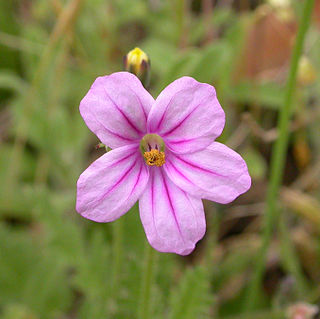
Erodium botrys is a species of flowering plant in the geranium family known by the common names longbeak stork's bill, Mediterranean stork's-bill and broadleaf filaree.

Gentiana newberryi is a species of gentian known by the common names alpine gentian and Newberry's gentian.
Gentiana plurisetosa is a rare species of Gentiana, known by the common names Klamath gentian and bristly gentian.

Geranium bicknellii is a species of geranium known by the common names Bicknell's cranesbill and northern cranesbill. It is native to much of the northern half of North America, where it can be found in a number of forest and woodland habitats. This is an annual or biennial herb which grows hairy stems up to about half a meter long. It may be erect or lie near the ground. Each leaf is several centimeters long and wide and is divided into several lobes, each of which may have smaller lobes or teeth. Flowers grow singly or in pairs and have pointed sepals and small lavender petals, each with a notch in the tip. The fruit has a rounded body with a long, straight style about 2 centimeters in length and tipped with a small beak.

Geranium californicum is a species of Geranium known by the common name California cranesbill. It is endemic to California, where it grows in the Sierra Nevada and coastal ranges in the southern part of the state.

Geranium carolinianum is a species of geranium known by the common name Carolina crane's-bill, or Carolina geranium. This species is native to North America, where it is widespread and grows in many types of habitat. There are two varieties; Geranium carolinianum var. carolinianum and the Geranium carolinianum var. sphaerospermum. This is a summer or winter annual herb. It can be considered invasive depending on the region, when it is found in the United States it is considered to be native.

Horkelia fusca is a species of flowering plant in the rose family known by several common names, including pinewoods horkelia and dusky horkelia. It is native to the western United States from California to Wyoming, where it is generally found in mountain forests and meadows. This perennial herb forms a thick tuft of leaves, each growing erect up to 15 centimeters tall. Each leaf is made up of wedge-shaped or rounded leaflets with toothed or lobed edges. These are often gray-green and somewhat hairy. The brown or reddish hairy stem reaches a maximum height near 60 centimeters and holds an inflorescence of several clusters of flowers. Each flower has small, pointed bractlets beneath larger green, red, or magenta sepals and five white to pinkish petals. The center of the flower has a ring of ten stamens around a bunch of 10 to 20 small pistils.

Antennaria luzuloides is a North American species of flowering plants in the daisy family known by the common name rush pussytoes. The species is native to western Canada and the western United States.
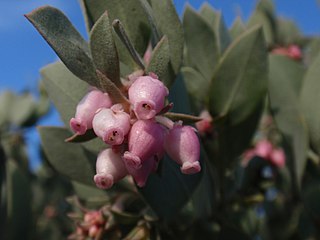
Arctostaphylos canescens, common name hoary manzanita, is a species of manzanita.
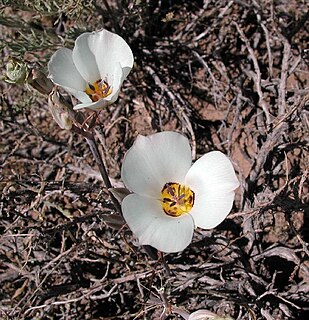
Calochortus bruneaunis is a species of flowering plant in the lily family, and is known by the common name Bruneau mariposa lily.
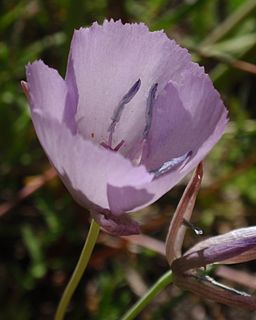
Calochortus nudus is a North American species of flowering plant in the lily family known by the common name naked mariposa lily.
Erodium brachycarpum is a species of flowering plant in the geranium family known by the common names hairy-pitted stork's-bill and shortfruit stork's bill. It is native to southern Europe but it is known elsewhere as an introduced species and often a weed, such as the west coast of the United States where it is widespread in California and Oregon.
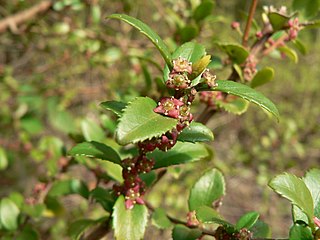
Paxistima myrsinites is a species of shrub in the family Celastraceae. It is native to western North America from British Columbia to northern Mexico to the Rocky Mountains, where it grows in forests, often in the understory.

Phacelia argentea is a rare species of phacelia known by the common names sand dune phacelia and silvery phacelia. It is native to the coastline of southwestern Oregon and far northwestern California, where it was counted at a total of 33 sites in 1995. It is the only phacelia species endemic to coastal sand dune habitat, an ecosystem which is altered and declining in the area.
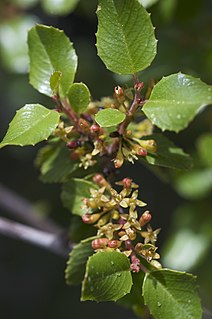
Rhamnus ilicifolia is a species of flowering plant in the buckthorn family known by the common name hollyleaf redberry. It is native to western North America, where it is a common plant growing in many types of habitat, including chaparral and wooded areas, from Oregon through California, to Baja California and Arizona.

Romanzoffia californica is a species of flowering plant in the borage family known by the common name California mistmaiden. It is native to Oregon and northern California, where it grows in moist and wet habitat, such as coastal bluffs and mountain forests.

Trifolium obtusiflorum is a species of clover known by the common name clammy clover. It is native to California in the Peninsular, Transverse, Sierra Nevada, and the California Coast Ranges and Cascade Range into southwestern Oregon.

Viola praemorsa is a species of violet known by the common names canary violet, Astoria violet, and yellow montane violet.


















